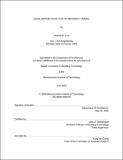Equilibrium analysis of masonry domes
Author(s)
Lau, Wanda W
DownloadFull printable version (7.743Mb)
Other Contributors
Massachusetts Institute of Technology. Dept. of Architecture.
Advisor
John A. Ochsendorf.
Terms of use
Metadata
Show full item recordAbstract
This thesis developed a new method to analyze the structural behavior of masonry domes: the modified thrust line analysis. This graphical-based method offers several advantages to existing methods. It is the first to account for the ability of domes to achieve a range of internal forces, gaining potentially an infinite number of equilibrium solutions that could not be derived otherwise. This method can also analyze non-conventional axisymmetrical dome geometries that are difficult or impossible to analyze with existing methods. Abiding by limit state conditions and the principles of the lower bound theorem, the modified thrust line method was used to ascertain the theoretical minimum thrust of spherical and pointed domes, a parameter that was previously unsolved. Several methods to estimate minimum thrust to-weight ratio were provided. For spherical domes, this ratio may be estimated as -0.583[alpha] + 1.123; for pointed domes, the estimated ratio is 0.551[delta] -1.061[delta]/[alpha] -0.615[alpha] + 1.164, where [alpha] and [delta] are the embrace and truncating angles, respectively. (cont.) From the results, salient relationships between minimum thrust and dome geometry were derived, including an inverse relationship between the minimum thrust and the thickness-to-radius ratio, angle of embrace, and, for pointed domes, the truncation angle of the crown for a constant angle of embrace. The capabilities of the modified thrust line method were demonstrated in two masonry dome case studies that existing methods could not successfully analyze. The potential of this method to predict the ultimate load capacity of masonry domes was also explored. The method overpredicted the capacity of two small-scale masonry domes loaded to failure by a concentrated applied load at the crown; however the small size of the domes compared to real-world domes suggested that scale effects may have influenced their behavior. Finally, interactive geometry programs of the modified thrust line method and other existing graphical analysis methods were created to disseminate these illustrative tools to understanding the structural behavior of masonry domes.
Description
Thesis (S.M.)--Massachusetts Institute of Technology, Dept. of Architecture, 2006. This electronic version was submitted by the student author. The certified thesis is available in the Institute Archives and Special Collections. Includes bibliographical references (p. 121-123).
Date issued
2006Department
Massachusetts Institute of Technology. Department of ArchitecturePublisher
Massachusetts Institute of Technology
Keywords
Architecture.